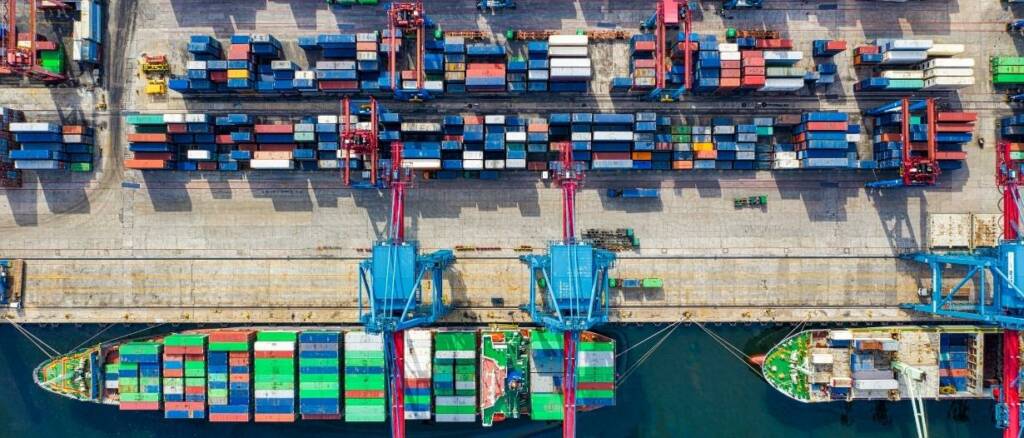Just as China’s trade sector recovers from a fresh wave of COVID-19 lockdowns, the world’s largest exporter now faces a slimmer order book amidst weakening global sentiment and increased belt-tightening measures linked to inflation.
After decades of seeming invincibility to global downturns, China’s economy is now looking increasingly vulnerable.
In their forecast for June 2022, the World Bank suggested that the Chinese economy may be headed for a slowdown:
“After a strong start in early 2022, the largest COVID-19 wave in two years has disrupted China’s growth normalization.
“We project real GDP growth to slow sharply to 4.3 percent in 2022 – 0.8 percentage points lower than projected in the December China Economic Update.
“This downward revision largely reflects the economic damage caused by Omicron outbreaks and the prolonged lockdowns in parts of China from March to May.”

Port congestion and supply chain issues
Aside from factory closures – a major blow to GDP given that manufacturing accounts for nearly 30% of the country’s total economic output – the damage also stemmed from shutdowns at Shanghai, one of China’s main commercial ports and a hub for many key supply chains.
This had a huge knock-on effect, creating product shortages globally, but also leading to port congestion elsewhere, particularly on trans-Pacific routes to the US.
Although this led to short-term gains for China’s container shipping sector, which benefited from an unprecedented boom in both demand and overall shipping rates, many expect that this will also contribute to a decrease in volume going forward as prices become too high, leading to order cancellations.
The result is a downward spiral in which demand starts to decrease just as capacity and output increase.
As a large producer and exporter of goods, China’s economy is very vulnerable to changes in external demand from customers beyond their borders.
Thanks to the conflict in Ukraine, and its knock-on effect on commodity prices as well as inflation rates, the country now faces the potential problem of a shrinking export market.
The UK Institute of Export predicts that this will affect the growth outlook for Chinese trade going forward.
“Even though China’s economy grew by 4.8% in Q1 of 2022, experts suggest that outbound shipments will weaken, while imports will also fall,” the report says.
UK imports
As the UK’s third-largest trading partner (current estimates for total trade on goods and services sit at approximately £93.0 billion per annum), any change in China’s fortunes or output could end up having major consequences for the UK:
“Currently, China is the UK’s third-largest trading partner (accounting for 7.3% of total UK trade), meaning any sudden contraction could have big implications for UK businesses,” the UK Institute of Export predicts.
Threat of contagion from the real estate market
On top of that, China has also been dogged by a number of internal problems that could impact their wider economic prospects, such as the persistent debt issues in the real estate sector – something highlighted by the Evergrande debacle, which sent panic through financial markets in September 2021 due to the fear of contagion.
Many commentators have warned that if China reverts to historical measures to boost the economy through “debt-financed infrastructure and real estate investment,” then it could run the risk of adding fuel to the flames.
According to the World Bank this growth model “is ultimately unsustainable,” not least because “the indebtedness of many corporates and local governments is already too high.”

Silver linings?
On the bright side, export volumes went up by 16% in May as lockdowns began to ease, and many experts foresee continued demand going forward as supply chains get back to normal.
With peak shipping season in the lead-up to the US fall shopping season less than a few months away, any short-term drops in volume are likely to be short-lived.
This appears to be borne out by previous statistics; after experiencing a fall of around 18% in the first quarter of 2022 due to the outbreak of the Russia-Ukraine conflict, the Shanghai Containerized Freight Index (SCFI) averaged 4,162 points in May 2022.
To put this into perspective, this number is still 4.3% above previous highs recorded in 2019.
Going forward, Fitch Ratings believes that the outlook for this sector as a whole should remain bullish for the remainder of 2022, although they warn of a potential slowdown in 2023:
“Container shipping is poised for another very strong year in 2022, but Fitch Ratings expects challenges in 2023, which could result in a test of the industry’s discipline or whether companies are better placed than in the last downturn, given the high cash balances, more consolidated market positions and diversifying bolt-on acquisitions.”
Future economic outlook
The World Bank is also not entirely pessimistic about China’s future economic growth prospects.
Despite ongoing risks, both to the world and the Chinese economy, they were hopeful that growth momentum would “rebound during the second half of 2022, helped by aggressive policy stimulus to mitigate the economic downturn.”
For World Bank economists though, much will depend on whether China is able to bring COVID-19 infections down sufficiently to fully re-open in places like Shanghai, and if its stimulus package, consisting of “large public spending, tax rebates, policy rate cuts, and a more dovish stance on the property sector,” works:
“While China has the macroeconomic space to counter the growth slowdown, the dilemma facing decision-makers is how to make the policy stimulus effective, as long as mobility restrictions persist,” the organisation’s report says.
































